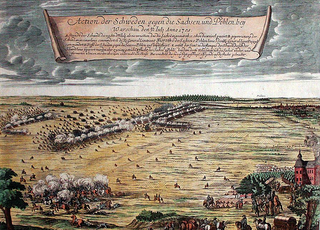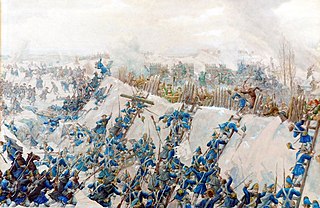
The Battle of Lesnaya was one of the major battles of the Great Northern War. It took place on October 9 [O.S. September 28] 1708 between a Russian army of between 17,000 and 29,000 men commanded by Peter I of Russia, Mikhail Mikhailovich Golitsyn, Aleksandr Danilovich Menshikov, Rudolph Felix Bauer and Nikolai Grigorovitj von Werden and a Swedish army between 12,500 and 16,000 men commanded by Adam Ludwig Lewenhaupt and Berndt Otto Stackelberg, at the village of Lesnaya, located close to the border between the Polish–Lithuanian Commonwealth and Russian Empire. The Swedes were escorting a supply column of more than 4,500 wagons for their main army in Ukraine.

In the Great Northern War (1700–1721) a coalition led by the Tsardom of Russia successfully contested the supremacy of the Swedish Empire in Northern, Central and Eastern Europe. The initial leaders of the anti-Swedish alliance were Peter I of Russia, Frederick IV of Denmark–Norway and Augustus II the Strong of Saxony–Poland–Lithuania. Frederick IV and Augustus II were defeated by Sweden, under Charles XII, and forced out of the alliance in 1700 and 1706 respectively, but rejoined it in 1709 after the defeat of Charles XII at the Battle of Poltava. George I of Great Britain and the Electorate of Hanover joined the coalition in 1714 for Hanover and in 1717 for Britain, and Frederick William I of Brandenburg-Prussia joined it in 1715.

The Battle of Poltava was the decisive and largest battle of the Great Northern War. The Russian army under the command of Tsar Peter I defeated the Swedish army under the command of Carl Gustaf Rehnskiöld. The battle put an end to the status of the Swedish Empire as a European great power, as well as its eastbound expansion, and marked the beginning of Russian supremacy in eastern Europe.

The Battle of Holowczyn was fought in July 1708 between the Russian army, and the Swedish army, led by Charles XII of Sweden, only 26 years of age at the time. Despite difficult natural obstacles and superior enemy artillery, the Swedes were able to achieve surprise and defeat the numerically superior Russian forces, who were separated from each other, had no overall command and could not coordinate their actions, disallowing them an engagement in full force. Reportedly, it was Charles' favourite victory.

The Great Wrath was a period of Finnish history dominated by the Russian invasion and subsequent military occupation of Finland, then part of the Swedish Empire, from 1714 until the Treaty of Nystad (1721), which ended the Great Northern War.

Count Carl Gustav Rehnskiöld was a Swedish Field Marshal (fältmarskalk) and Royal Councillor. He was mentor and chief military advisor to King Charles XII of Sweden, and served as deputy commander-in-chief of the Carolean Army, an army he assisted both in its education and development.

The invasion of Russia by Charles XII of Sweden was a campaign undertaken during the Great Northern War between Sweden and the allied states of Russia, Poland, and Denmark. The invasion began with Charles's crossing of the Vistula on 1 January 1708, and effectively ended with the Swedish defeat in the Battle of Poltava on 8 July 1709, though Charles continued to pose a military threat to Russia for several years while under the protection of the Ottoman Turks.

The Battle of Molyatichi, also known as the Battle of Dobroye, took place on August 31, 1708 at Molyatichi during the Great Northern War. The Russian army of Peter the Great under the command of Mikhail Golitsyn launched a surprise attack on the isolated vanguard of Charles XII's Swedish Army, under the direct command of Carl Gustaf Roos, in order to destroy it. Their cavalry was unable to arrive in time to cut Roos' command off before Swedish reinforcements arrived, forcing the Russians to retreat.

The Battle of Grodno (1706) refers to the battle during the Great Northern War. Grodno was a city of the Polish–Lithuanian Commonwealth at this time.

The Battle of Warsaw was fought on 31 July 1705 near Warsaw, Polish–Lithuanian Commonwealth, during the Great Northern War and Swedish invasion of Poland (1701–1706). The battle was part of a power struggle for the Polish–Lithuanian throne. It was fought between Augustus II the Strong and Stanisław Leszczyński and their allies. Augustus II entered the Northern war as elector of Saxony and king of the Polish–Lithuanian Commonwealth, and had formed an alliance with Denmark–Norway and Russia. Stanisław Leszczyński had seized the Polish throne in 1704, with the support of the Swedish army of Charles XII of Sweden. The struggle for the throne forced the Polish nobility to pick sides; the Warsaw Confederation supported Leszczyński and Sweden, and the Sandomierz Confederation supported Augustus II and his allies. The conflict resulted in the Polish civil war of 1704–1706.

The Battle of Krasnokutsk–Gorodnoye took place on February 20–22, 1709, in the Swedish campaign of Russia during the Great Northern War. The Swedish troops were directly led by Charles XII of Sweden who pursued a force of Russians commanded by Otto Rudolf von der Schaumburg from the minor battle of Krasnokutsk to the town of Gorodnoye (Horodnje) where a new battle took place, with the Russians now commanded by Karl Evald von Rönne. The Swedes were victorious but cancelled their offensive as night fell.

The Swedish invasion of Poland (1701–1706), also known as Charles XII's invasion of Poland or the Polish front of the Great Northern War, was a conflict in eastern Europe overshadowed by the ongoing Great Northern War fought between the Swedish Empire against the Russian Empire, Denmark-Norway, Saxony and the Polish–Lithuanian Commonwealth. The Polish front was a major part of the greater conflict, and it included some decisive battles in favor of the Swedes that contributed to the length of the war.
The Battle of Rajovka took place on 20 September 1708 near Rayevka, Smolensk during the Swedish invasion of Russia in the Great Northern War. The Swedish army of about 2,400 men under the command of Charles XII defeated the Russian army of 10,000 men under Christian Felix Bauer after a fierce cavalry skirmish where the king himself was in great danger.
The Battle of Oposhnya took place on February 8, 1709 during the Swedish invasion of Russia in the Great Northern War.
The Battle of the Neva took place on September 9, 1708, during the Ingrian campaign of 1708 during the Great Northern War.

The siege of Veprik took place on 3–18 January 1709 during the Swedish invasion of Russia in the Great Northern War.

The Campaign of Grodno was a plan developed by Johann Patkul and Otto Arnold von Paykull during the Swedish invasion of the Polish–Lithuanian Commonwealth, a part of the Great Northern War. Its purpose was to crush Charles XII's army with overwhelming force in a combined offensive of Russian and Saxon troops. The campaign, executed by Peter I of Russia and Augustus II of Saxony, began in July 1705 and lasted almost a year. In divided areas the allies would jointly strike the Swedish troops occupied in Poland, in order to neutralize the influence the Swedes had in the Polish politics. However, the Swedish forces under Charles XII successfully outmaneuvered the allies, installed a Polish king in favor of their own and finally won two decisive victories at Grodno and Fraustadt in 1706. This resulted in the Treaty of Altranstädt (1706) in which Augustus renounced his claims to the Polish throne, broke off his alliance with Russia, and established peace between Sweden and Saxony.
The Battle of Wismar took place on December 5, 1711 close to Wismar, Swedish Empire during the Great Northern War. A 3,000 strong Danish force under the command of Jørgen Rantzau blocked the Swedish city of Wismar. The Swedes under Martin von Schoultz, sent out 2,500 men from their garrison in an attempt to surprise the Danish forces camping a distance away. However, the Danish commander got words of the approaching Swedes and countered them, resulting in 478 Swedes dead, with another 1,500 captured to only 300 Danes killed and wounded.

The Battle of Koporye took place on October 8, 1708 close to Koporye, in the Swedish Empire during the Ingrian campaign in the Great Northern War. A Swedish force consisting of 1,800 men under the command of generals Carl Gustaf Armfeldt and Anders Erik Ramsay attacked a numerically stronger enemy of between 2,000 and 3,000 Russian forces. The battle ended in a Swedish victory with about 600 Russians killed and only 70 dead among the Swedish force. After further campaigning, the Swedish–Finland army under the command of Georg Lybecker decided to evacuate his troops, having failed at his objectives.

The Great Northern War in Ukraine (1708–1713) — war between the Tsardom of Russia on one hand and the Swedish Empire and the Ottoman Empire on the other.













